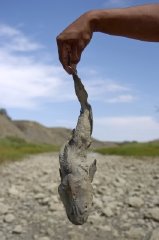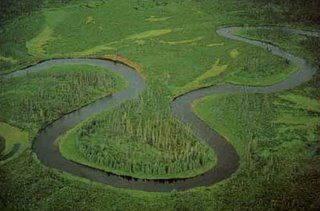In my previous entries on the topic of water, water scarcity, water quality, and other topics related to water which amount to nineteen making this my twentieth, I have mainly concerned myself with areas outside of the United States. That is mainly because other areas such as Niger, Sudan, Kenya, Somalia and other countries in Africa are experiencing life threatening and life taking repercussions because of the lack of safe, clean, potable water just to meet every day needs, and people are killing each other to get it.
Countries such as India, Pakistan, and China are experiencing an increase in pollution, waste, and privatization that seeks to threaten indigenous peoples and disgrace their traditions all in the name of profit. The Middle East is also experiencing crisis level water shortages with many of the countries involved also engaged in war, which does little to help mitigate the humanitarian disaster lack of potable water, pollution, and fighting over water rights creates for the people living there. These are topics that go to the core of who we are as human beings in how we approach the problem and seek to solve it. Which up to this point has proven that we as a species need much more work in order to reach a point where this crisis can be solved. And we do have the means to solve it.
However, the United States has it own problems involving privatization (which I did touch on,) drought ( the Southwestern US has been experiencing a very bad drought with New Mexico just recently placing very strict restrictions on water usage,) and according to this report, The Great Lakes is experiencing a drop in water table that I believe should cause worry, especially in light of the reasons cited for its occurrence.
CORRECTED: Low water in North America's Great Lakes causes worryLink from Yahoo. May be broken.
Wed Jul 5, 1:48 PM ET
Corrects ranking of Great Lakes in paragraph three as source of freshwater from world's largest to second-largest after Siberia's Lake Baikal.
By Jonathan Spicer
TORONTO (Reuters) - Several massive vessels have run aground on Michigan's Saginaw River this shipping season, caught in shallow waters a few miles from Lake Huron. The river port is as shallow as 13 feet in a passage that is supposed to be 22 feet deep, a sign of low water levels in North America's five Great Lakes -- Superior, Michigan, Huron, Erie, and Ontario.Water levels declined in 1998 and have remained low, forcing ships to take on lighter loads and sparking concern about shorelines and wetlands in the Great Lakes, the world's second-largest supply of freshwater after Siberia's Lake Baikal and a major commercial shipping route for Canada and the United States. Iron ore and grain are among the biggest cargoes shipped on the lakes.
"It's a pretty different mindset to come off 30 years of above-average water levels and to suddenly, since the late 1990s, have below-average levels," said Scott Thieme, chief of the U.S. Army Corps of Engineers' Great Lakes Hydraulics and Hydrology Office in Detroit. Lakes Huron and Michigan, where water levels have declined the most, are down about 3 feet (one meter) from 1997 and about 20 inches from their 140-year average, according to the U.S. National Oceanic and Atmospheric Administration's Great Lakes Environmental Research Laboratory.
When homeowners on Lake Huron's Georgian Bay noticed wetlands were drying up, the Georgian Bay Association funded a $223,000 report that last year concluded shoreline alterations such as dredging and erosion in the St. Clair River, at the bottom of the lake, were responsible. In partial response, U.S. and Canadian governments approved funding for a $14.6 million study of the upper Great Lakes by the International Joint Commission, which resolves border disputes and was denied funds for a similar study in 2002. Depending on what it finds, the commission could recommend changes to the amount of water that flows out of Lake Superior, the first and largest in the chain of lakes.
NATURAL CAUSES?
Water levels in the Great Lakes have always fluctuated, but experts point to climate change, dredging, private shoreline alterations and even lingering effects of glaciers to explain the latest changes -- the decline of Lake Huron and slightly higher water levels in Lake Erie, into which Huron flows. The most controversial of several dredging projects was in 1962, when the U.S. Army Corps of Engineers deepened the St. Clair River channel by 2 feet to accommodate commercial shipping. "When they dredge a river, it's like taking a straw and widening it," said hydrologist Cynthia Sellinger, who helped plan the upper Great Lakes study, which begins this summer.
U.S. and Canadian governments approved the 1960s dredging on condition that submerged sills be built to compensate for water lost from Lake Huron, and they started a series of studies. But by the time the studies were completed in the 1970s, water levels in Lakes Huron and Michigan were at record highs, and no one wanted sills that would raise levels even more. Experts are unsure why water levels in the upper lakes rose soon after the St. Clair River dredging. But they say that major climatic events usually coincide with changes in water levels.
The 1930s Dust Bowl drought coincided with then-record low levels in the Great Lakes. And the most recent decline was in 1997, when a strong El Nino brought warm, dry temperatures to North America, Sellinger said. In addition, above-average temperatures since 1998 mean less ice forms on the Great Lakes and the rivers that flow into it, and more water evaporates away, Sellinger said. And then there is something called post-glacial rebound, or the slow rise of the earth's crust, that could partly explain declining water levels in Lakes Huron and Michigan.
"The area around Georgian Bay (Lake Huron) is rising faster than the area around Lake Erie so it may be that the land has just tilted and more water is flowing out," Sellinger said.
DECLINING REVENUE
For every inch water levels go down, ships bound for destinations outside North America forfeit about $8,400 in freight revenue, said Dennis Mahoney, president of the United States Great Lakes Shipping Association. Saginaw and other ports have done emergency dredging to accommodate ships and barges that can be hundreds of yards long. But Lake Superior's largest American ships carried 3,000 fewer short tons of cargo last year than in 1997, when water levels were 12 inches higher, according to the Lake Carriers' Association. "Obviously water levels are crucially important to this industry, and we have been in a period of decline," said Glen Nekvasil, vice president of corporate communications for the association. "When you're not utilizing your full vessel capacity you can't give your customer the best freight rate."
end of excerpt.
~~~~~~~~~~~~~~~~~~~~~~~~~~~~
Per Wikipedia:
Types of dredgingCapital dredging: carried out to create a new harbor or berth or waterway, or deepen an existing one in order to allow larger ships to use it. It is usually carried out with a cutter-suction dredge.
Maintenance dredging: deepening navigable seaports and waterways which have become silted with the passage of time, due to sand and mud deposited by water currents, until they may become too shallow for navigation. This is often carried out with a trailing suction hopper dredge. Most dredging is for this purpose.
Land reclamation: mining sand, clay or rock from the seabed and using it to construct new land. This is typically performed by a cutter-suction dredge or trailing suction hopper dredge.
Beach Nourishment: mining sand offshore and placing on a beach to replace sand eroded by storms or wave action. This is done to enhance the recreational and protective function of the beaches. This is typically performed by a cutter-suction dredge or trailing suction hopper dredge.
Removing trash and debris from the bottoms of rivers and canals and harbors.
Getting useful material from the seabed. One possible type in the future, is recovering natural metal ore nodules from the abyssal plains.
Contaminant remediation. Dredging is often used to reclimate areas affected by chemical spills, storm water surges (with urban runoff), and other soil contaminations. Disposal becomes an aproportionatly large factor in these operations.
Anti-eutrophication. Dredging is an (expensive) option for the remediation of eutrophied (or de-oxygenated) water bodies. As artificialy elevated phosphorus levels in the sediment aggrivate the eutrophication process, controlled sediment removal is occasionally the only option for the reclimation of still waters.
~~~~~~~~~~~~~~~~~~~~
Now, I'm no expert on dredging, but it would seem to me that this process takes water away from the body of water you are dredging, and can disturb the ecological balance of the area being dredged if proper measures are not adhered to in replacing it.
The Great Lakes is an especially delicate ecological system, so it would seem obvious that such dredging for purposes of digging deeper to allow cargo ships to pass through would cause an imbalance to the eco-systems there over time.
And of course, climate change while it may not have as significant an effect here as it does in say, Kenya, can greatly influence the water table with more water in the cycle being evaporated before that cycle is completed. Thirty three million people live in the area of the Great Lakes and would be directly impacted from water tables going lower. It would not only cause loss of revenue for shipping companies that do business between Canada and the United States making their services more expensive, it would also tip the scale of ecological balance in this fragile and beautiful area, and leave millions in danger of losing their only source of water.
This report dated from the year 2000 gives a very indepth explanation of the condition of The Great Lakes, including repercussions from climate change (Section 5) and other factors, and gives good recommendations for mitigating its effects in the future:
Protection Of The Waters Of The Great LakesSo for those who do not really think this is not an important issue because up to date all they have read about is a drought in Kenya which they say doesn't affect them as they live on the other side of the world, the Great Lakes is on YOUR side of the world:
~~~~~~~~~~~~~~~~~~~~~~~~~~
The Great LakesFrom the link:
Overview
The environment of the Great Lakes region is blessed with huge forests and wilderness areas, rich agricultural land, hundreds of tributaries and thousands of smaller lakes, and extensive mineral deposits. The region's glacial history and the tremendous influence of the lakes themselves create unique conditions that support a wealth of biological diversity, including more than 130 rare species and ecosystems.
The environment supports a world-class fishery and a variety of wildlife, such as white-tailed deer, beaver, muskrat, weasel, fox, black bear, bobcat, moose and other furbearing animals. Bird populations thrive on the various terrains, some migrating south in the winter, others making permanent homes. An estimated 180 species of fish are native to the Great Lakes, including small- and large-mouth bass, muskellunge, northern pike, lake herring, whitefish, walleye and lake trout. Rare species making their home in the Great Lakes region include the world's last known population of the white catspaw pearly mussel, the copper redhorse fish and the Kirtland's warbler.
The region's sand dunes, coastal marshes, rocky shorelines, lakeplain prairies, savannas, forests, fens, wetlands and other landscapes contain features that are either unique or best represented withink the Great Lakes basin. For example, the world's largest freshwater dunes line the shores of Lake Michigan.
Over the course of history, many types of pollution have inflicted and been reduced in the region, yet significant challenges remain. These range from threats to divert water out of the Great Lakes basin to the introduction of nonindigenous invasive species and airborne toxics into the basin. Protection of water quality and sustainable development remain long-term goals.
~~~~~~~~~~~~~~~~~~~~~~~~~~~~~~~~~~
And it has a rich environmental heritage that also has been exploited due to population, over consumption, and threats of water from these lakes being diverted. Should the global water crisis in conjunction with the climate crisis we face get any worse, which scientists predict will happen should we not take the necessary steps now to mitigate it, how long before the droughts people face in Africa hit here? The Southwestern United States is already under a severe drought watch and has been for months.
Even in the Northeast where I live, we too have experienced periods of prolonged drought and excessive weather, especially recently with flooding that reached from NY, to Pennsylvania, to Maryland, even to Washington DC. And whether you even believe that climate change is human induced or not (which there truly is no debate regarding human contribution to it) the effects of it are just as deadly and need to be faced in ways that seek as great a level of sustainability for all with also preserving the delicate balance of our planet.
The Great Lakes, Huron, Ontario, Michigan, Erie, and Superior (which is the order I learned them in grade school to spell HOMES which I never forgot;-)) and the the bodies of water that connect with them are the largest source of freshwater on Earth next to Lake Baikal in Siberia. You can even see it from the moon as it spans 94,000 square miles and holds 6 quadrillion gallons of water, which is about nine-tenths of the U.S. supply.
Don't you think how we maintain this system is essential to our lives and the lives of our children? I do, and that's why I report on these water issues, because WATER IS LIFE. And The Great Lakes must be preserved for our future. It is good to know that there are so many groups in the states that adjoin this Earthly wonder that care for that as well. My hope is that in the future conditions will be such that we can share this bounty of the Earth equitably and peacefully, and work to change the conditions that are now causing so many concern for where the future of this water lies.






